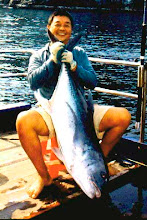 |
| Fly fishing is very effective for catching pacu. |
Just like the peacock bass, the pacu was first brought into the country as aquarium pets. Later, because of its fast growing abilities and size, some fish farmers reared them as food fish. The Malaysian public never cultivated a taste for its meat so it never gain as much popularity as the tilapia. As a result it was relegated to be stock in pay ponds, where anglers pay to fish for them.
With its flattened and deep body, the pacu was really built for sport fishing on light tackles. They never acquired the nickname “freshwater GTs” by accident you know. As an omnivore, it can easily be caught by using oil palm seeds as bait. I would like to stress here that circle hook is highly recommended so as to cause the least damage to these flat warriors. As they also feed on insects and small fishes, they can be caught on flies and lures too. The fly patterns that I normally use are the clousers, minnow looking flies and dragonfly nymphs. Tough tippet should be use for fly fishing as the teeth of the fish can easily gnaw through most mono lines. Rattling minnow like lures of 10cm to 15cm are known to be effective for catching pacus too.
The general understanding is this fish cannot breed in Malaysian water and climate. But lately rumors have surfaced that juvenile pacus were caught somewhere in Johor. So to be safe, this alien species should not be release indiscriminately into our water.
www.malaysia-chronicle.com
I found this report about the pacu fish at this site. It seems some pacu were released in Papua New Guinea some 15 years ago. Due lack of food, they turned carnivourous. A number of fishermen had their testicles bitten off resulting in deaths. What I suspect is the pacu, now nicknamed, ball cutters, mistook the testicles for nuts or seeds which were their staple diet back in the Amazon River.
 |
| This pacu was caught when it grabbed the clouser fly. |
 |
| You can see the teeth of the pacu. They can easily gnaw through monofilament leaders or tippets. |
 |
| This nice specimen fell for a dragonfly nymph fly. |
 |
| A Halco lure was its downfall. This one really put up a good fight. |
 |
| After about fifteen minutes of fight, the tippet was cut by this pacu. |
 |
| This too was caught when it grabbed my Halco lure. |
